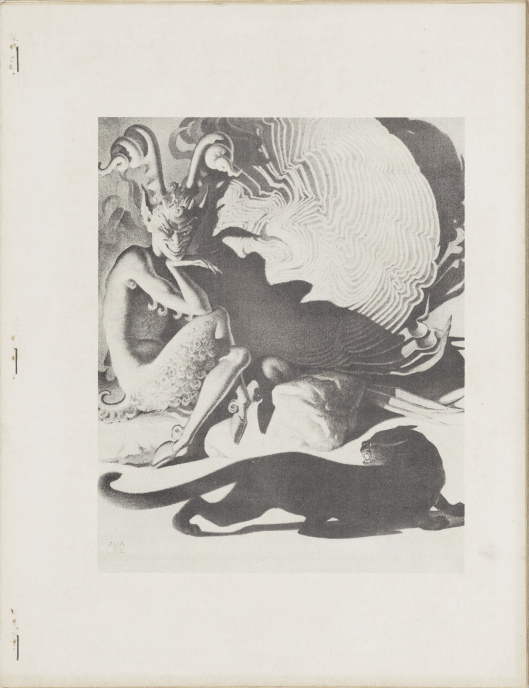A new clean scan of Lovecraft’s “Homes and Shrines of Poe” article. Originally in The Californian for Winter 1934, but here scanned from the early Lovecraft fanzine The Acolyte for Fall 1943. So far as I’m aware, despite its public domain status, the essay is only otherwise available in Collected Essays, Volume 4: Travel and via a rather clunky tiling image-viewer format at the Iowa Digital Library.
The issue is not on Archive.org, as yet, but they have The Acolyte for Summer 1945 with “Interlude with Lovecraft” by Stuart M. Boland, outlining his now-lost correspondence with R.E. Howard and H.P. Lovecraft in the mid 1930s. I see that Bobby Derie expertly scrutinised both of Boland’s 1945 claims in 2017, in an excellent long blog post “A Lost Correspondence: Robert E. Howard and Stuart M. Boland”. I’ve now added his essay to my Open Lovecraft listing, since the latter part concerns Lovecraft.
The Acolyte for 1944 Summer has a reprint of Lovecraft’s “8th century” warrior poem, done as a translation into a slightly stiff (perhaps deliberately so?) Victorian-era English. Possibly that poem is only otherwise available in The Ancient Track?
Other issues of The Acolyte are online in viewer form at the Iowa Digital Library. These have: Lovecraft’s “Poetry and the Artistic Ideal”; his “Notes on Interplanetary Fiction”; “a “discarded draft” of “Innsmouth” (readable format) in an issue with a very fine cover (see below); and Hoffman Price’s memories of Lovecraft (appears to be the same as the text reprinted under a different title in the now rather expensive Lovecraft Remembered).
 Cover of the Spring 1944 issue of The Acolyte. The picture is signed “Ava Lee”, but inside the issue’s art is credited to “R. A. Hoffman and Alva Rogers”. Other covers by Alva are clearly signed “Alva Rogers” and are done in a much less refined style. R. A. Hoffman was the fanzine’s art director. I can find no details online of an “Ava Lee”. He/she apparently also produced a cover for the first issue, but the only scanned copy of No. 1 is missing the cover illustration. The artist was possibly trained/worked as a stage designer for the theatre, judging by the picture? It also appears to have been cropped from a wider landscape format picture, to make it fit a front-cover. Which again suggests it was originally a theatre-design concept illustration.
Cover of the Spring 1944 issue of The Acolyte. The picture is signed “Ava Lee”, but inside the issue’s art is credited to “R. A. Hoffman and Alva Rogers”. Other covers by Alva are clearly signed “Alva Rogers” and are done in a much less refined style. R. A. Hoffman was the fanzine’s art director. I can find no details online of an “Ava Lee”. He/she apparently also produced a cover for the first issue, but the only scanned copy of No. 1 is missing the cover illustration. The artist was possibly trained/worked as a stage designer for the theatre, judging by the picture? It also appears to have been cropped from a wider landscape format picture, to make it fit a front-cover. Which again suggests it was originally a theatre-design concept illustration.

Yes, “Regner Lodbrog’s Epicedium” is included in THE ANCIENT TRACK; but I also seem to recall that it has been published elsewhere. It actually IS an English translation of a Latin translation of an old Norse lay called “Krakumál” (however, “Krakumál” was most likely written down in the 12th century even though it tells of events that supposedly happened much earlier). Lovecraft found the Latin text in Hugh Blair’s commentary on THE SONGS OF OSSIAN, along with Blair’s attempt at an English translation (on which he seems to have relied a lot for his own translation); I wrote an article on “Regner Lodbrog’s Epicedium” (and some mistakes in translation committed by Lovecraft and Blair) for LOVECRAFT ANNUAL, but I can’t remember what issue.
And I should add that the Olaus Wormius mentioned is not the mythical translator of the Necronomicon but an actual Danish scholar (Olaus Wormius being a Latinisation of Ole Wurm) of the 17th century. Wormius, however, was not the translator; he merely published the Latin translation made by an Icelandic priest.
Thanks for that, Martin. Yes, I hadn’t thought to go looking for commentary on the poem, and just noted for readers that it was also printed in The Ancient Track. I now see that S. T. Joshi had an essay on it, “Lovecraft, Regner Lodbrog, and Olaus Wormius”, in Crypt of Cthulhu #89 (1995). The same essay can be found in Joshi’s Primal Sources book and also his new bumper book collection of his Lovecraft essays. Your own essay is in the 2012 issue of the Lovecraft Annual, titled “Of Regner Lodbrog, Hugh Blair, and Mistranslations”.